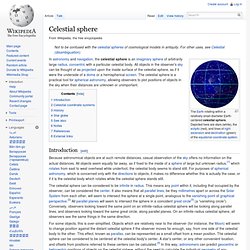

Constellation. There are also numerous historical constellations not recognized by the IAU or constellations recognized in regional traditions of astronomy or astrology, such as Chinese, Hindu and Australian Aboriginal.

Terminology[edit] The term circumpolar constellation is used for any constellation that, from a particular latitude on Earth, never sets below the horizon. From the north pole, all constellations north of the celestial equator are circumpolar constellations. Celestial sphere. In astronomy and navigation, the celestial sphere is an imaginary sphere of arbitrarily large radius, concentric with a particular celestial body.

All objects in the observer's sky can be thought of as projected upon the inside surface of the celestial sphere, as if it were the underside of a dome or a hemispherical screen. The celestial sphere is a practical tool for spherical astronomy, allowing observers to plot positions of objects in the sky when their distances are unknown or unimportant. Introduction[edit] For some objects, this is over-simplified. Objects which are relatively near to the observer (for instance, the Moon) will seem to change position against the distant celestial sphere if the observer moves far enough, say, from one side of the celestial body to the other.
SQ3. SQ2. SQ1. NQ4. NQ3. NQ2. NQ1. Quadrant (astronomy) A galactic quadrant, or quadrant of the galaxy, refers to one of four circular sectors in the division of the Milky Way galaxy.

Quadrants in the galactic coordinate system[edit] In actual astronomical practice, the delineation of the galactic quadrants is based upon the galactic coordinate system, which places the Sun as the pole of the mapping system.